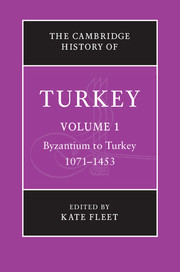Book contents
- Frontmatter
- 1 Introduction
- 2 The Byzantine Empire from the eleventh to the fifteenth century
- 3 Anatolia under the Mongols
- 4 Anatolia, 1300–1451
- 5 The incorporation of the Balkans into the Ottoman Empire, 1353–1453
- 6 Ottoman warfare, 1300–1453
- 7 The Turkish economy, 1071–1453
- 8 Art and architecture, 1300–1453
- 9 Social, cultural and intellectual life, 1071–1453
- Glossary
- Bibliography
- Index
- References
9 - Social, cultural and intellectual life, 1071–1453
Published online by Cambridge University Press: 28 March 2010
- Frontmatter
- 1 Introduction
- 2 The Byzantine Empire from the eleventh to the fifteenth century
- 3 Anatolia under the Mongols
- 4 Anatolia, 1300–1451
- 5 The incorporation of the Balkans into the Ottoman Empire, 1353–1453
- 6 Ottoman warfare, 1300–1453
- 7 The Turkish economy, 1071–1453
- 8 Art and architecture, 1300–1453
- 9 Social, cultural and intellectual life, 1071–1453
- Glossary
- Bibliography
- Index
- References
Summary
It is no easy task to write the social, cultural and intellectual history of Turkey between 1071 and 1453. Although the period is a long one, the material in the official chronicles is relatively limited. While we do possess information for the political history, the same unfortunately cannot be said for the social, cultural and intellectual life of the period since most of the sources we do have, the majority of which have been translated into western languages, deal with political history. Despite this difficulty, however, valuable information can be obtained from various sources, including travel books, even if their number is limited, literature, epics and hagiographies which shed light on different aspects of the subject. It nevertheless remains true that, presuming new sources do not come to light, it will continue to be very difficult to construct a clear or complete picture of the social and cultural life of the period with the exception, perhaps, of subjects such as science, literature, Sufism and art.
If we exclude the vakfiye (endownment deeds of vakifs, pious foundations) of the Seljuk and Ilkhan periods copied in the Ottoman period, it is clear that archival material of the type found in the Ottoman archives and which was without doubt also produced both in Seljuk Anatolia and in the period of Ilkhan domination has unfortunately not survived from those earlier periods.
- Type
- Chapter
- Information
- The Cambridge History of Turkey , pp. 353 - 422Publisher: Cambridge University PressPrint publication year: 2009
References
- 2
- Cited by



